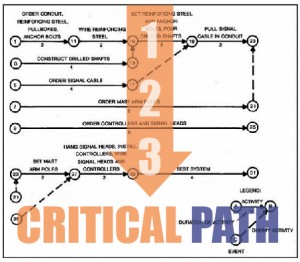
By Finance New Mexico
Businesses use many tools to keep projects and production on track, and most have used one or another of these with varying degrees of success.
The critical path method is the result of a mathematical approach to decision-making in project management, but it can be used to set deadlines for any business endeavor that includes multiple interdependent tasks. The critical path lists every task on a project trajectory and defines which are mandatory and which are more flexible.
For example, say a brewery owner plans to add a seasonal beer to her business’s existing lineup — a beer that could become a permanent offering if it draws a fan base. She approaches it like a math problem, identifying the variables involved, and considers alternate paths to her desired outcome until setting the critical path — the most efficient route.
If the entrepreneur has only to tweak a few aspects of her production line to produce her seasonal beer, her critical path will be relatively linear: One task will lead to another until the beer is poured in the customer’s glass.
But if the new product promises to introduce a blend of spices found only in Sri Lanka, layers of complexity are introduced to the assembly line. She has to find new suppliers and make import arrangements. Fresh marketing material must be written to alert the beer-drinking public to a product found nowhere else in North America.
The brewer’s new critical path comprises dozens of separate new tasks, and many are interconnected. One task — talking to a customs broker — can begin any time but must be completed before the raw materials are imported; another task — brewing the beer — can’t begin until all the ingredients are assembled.
Using the critical path method, the brewer lists every task or step involved in creating her new concoction, decides how long each step could take and identifies how — and where on the critical path — that task depends upon another task being done. Defining her path gives the entrepreneur a realistic deadline for brewing her first batch of seasonal beer.
Digging deeper, she sets a date by which each separate task will begin and end, allowing slack for tasks that can miss this ideal deadline without throwing the entire timetable off course. Tasks that must meet deadline are the essential mile markers on the critical path; when they hit snags, production slows or stops.
But peripheral tasks have deadlines, too, and require the brewer’s attention. A task with lots of slack can jump onto the critical path if it’s not done in time. For example, failure to print the new beer’s label by the time the bottles are ready for labeling can delay the advertised rollout of the new beer.
The critical path method takes time to learn, but once it’s mastered, a business can use it for a variety of initiatives.
For more business tools, visit www.financenewmexico.org.
Download 325_Business Projects Can Benefit From Following the Critical Path PDF
